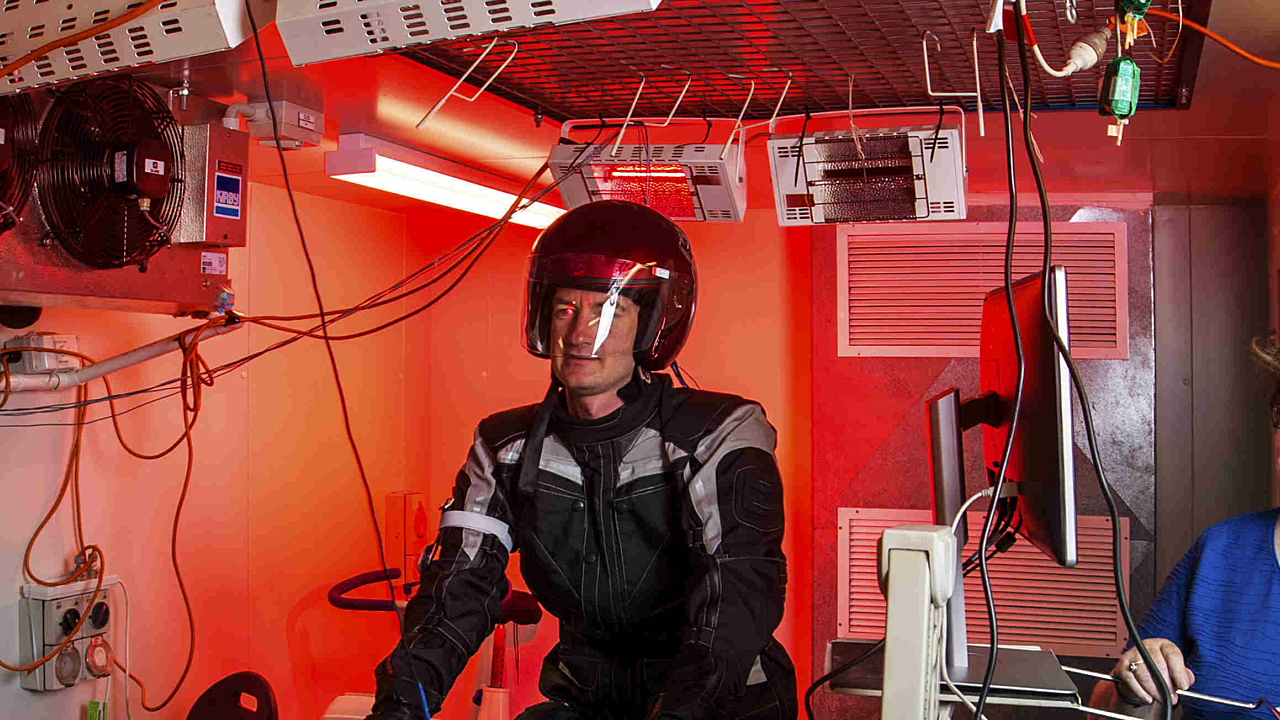Protective clothing can substantially reduce the risk of injury in crashes and yet a number of motorcyclists continue to ride in shorts and T‑shirts in hot weather.
Heat discomfort is the primary reason given by motorcyclists for not wearing protective clothing but little is known about the implications of such discomfort.
How hot do motorcyclists become when riding and is there a level of heat strain that could be physiologically damaging?
That’s a question now being closely examined for the first time in a collaborative study led by NeuRA’s Dr Julie Brown. It’s a timely study in light of the fact that the number of motorcycle riders, mainly recreational, has doubled in Australia over the past decade.
The multi-faceted project involves a collaboration between the University of Wollongong (Centre for Human and Applied Physiology) and Neuroscience Research Australia (NeuRA).
Work has now started in a climate chamber at UOW to discover just how hot motorcyclists become when riding during a simulated hot summer’s day, wearing full protective clothing and equipment.
Project Manager for the program and Senior Research Officer at NeuRA, Dr Liz de Rome, (and a recreational motorcyclist herself) said researchers hoped by the end of the study to be able to increase motorcyclists’ usage of protective clothing by identifying the design features and materials that are thermally efficient without compromising safety.
Dr de Rome said there have been few advances in motorcycle safety despite an unprecedented increase in the popularity of riding, with motorcycle registrations in Australia having almost doubled (93%) since 2002 compared to only 30% increase for all vehicles. In NSW each year about 2,500 riders are seriously injured and 60 are killed in crashes reported to police.
Previous research by Dr de Rome established that: purpose-designed motorcycle clothing can reduce the risk and severity of injuries in crashes and that high proportions of Australian riders do wear protective clothing but heat discomfort in hot weather is a key disincentive to usage.
The vast majority of riders wear motorcycle helmets (99.7%) and high proportions wear protective jackets (82%) with fewer wearing gloves (67%), protective pants (59%) or boots (57%). However usage rates vary according to conditions, with riders three times less likely to wear it in hot weather.
“Heat is a disincentive to usage because the materials required to provide injury protection tend to be heavy and lack ventilation which can restrict the body’s ability to regulate internal temperatures,” Dr de Rome said.
“This area of research with motorcyclists is challenging due to the difficulties and risks of measuring physiological function in real world riding.”
Motorcycle casualties are currently costing the Australian community in excess of $2 billion a year. The Federal Government’s National Road Safety Strategy 2011 – 2020 describes motorcycle injury crashes as a key road safety challenge of the decade and now includes increased usage of effective protective clothing by motorcyclists as an important aim for 2020.
“There is an urgent need to produce motorcycle protective clothing that is more suitable for hot climates if higher usage rates are to be achieved. The objective of this research proposal is to determine the specifications for motorcycle protective clothing that is both effective in preventing injury and thermally comfortable for use in the Australian climate,” Dr de Rome said.
Researchers are undertaking 48 trials (using 12 adults; 21 – 61 years) across four different climatic and clothing states. The trials in the UOW climate chamber will continue until early December
Thermal physiologist, Associate Professor Nigel Taylor, from UOW’s Centre for Human and Applied Physiology said riding a motorcycle in full protective clothing makes one hot, particularly in the summer, and there is some evidence to suggest that excessive heat strain might elicit some level of cognitive impairment.
“We need to know how much heat one produces when riding a motorcycle, since heat strain can arise from heat liberated during exercise as well as from external heat sources,” Professor Taylor said.
To do this, researchers studied experienced riding instructors from the Honda training school in Melbourne. Six riders rode over each of two courses — one simulating rural terrain and riding conditions, and the other simulating urban riding.
“We measured the rate at which they used oxygen (oxygen consumption), and this allowed us to determine how hard they were working,” Professor Taylor said.
Now researchers have turned to using UOW facilities and are at the half way point in that testing, with subjects tested under each of four experimental conditions in UOW’s climate-controlled chamber.
In each trial, subjects perform light exercise on a cycle ergometer (90 min) that matches the work rate of the riding instructors. During these trials, everybody is wearing protective boots, gloves and helmet. In one trial (the control condition), subjects will also wear jeans and a long-sleeved T‑shirt. This will be conducted at 25 degrees celsius. In each of the other three trials, they will wear full protective clothing, and these will occur at 25, 30 and 35 degrees celsius. In all trials, researchers are using radiant heaters to simulate full solar thermal load and a large-diameter fan to replicate the wind speed. Participants in the study are having their body core and skin temperatures measured.
Results of the study are expected to be made available by the end of 2015.




